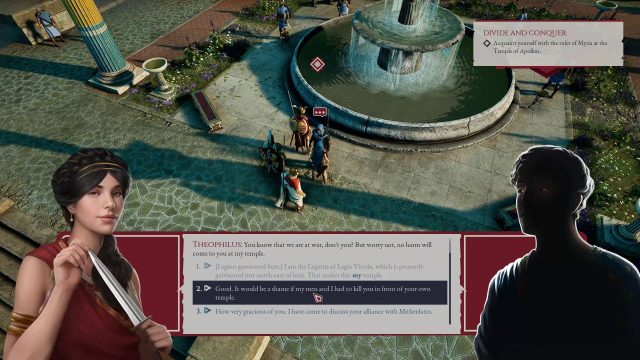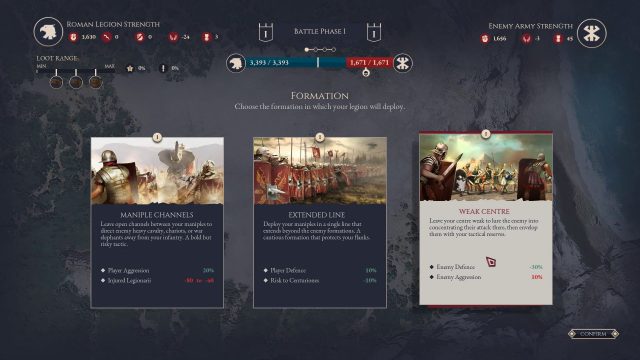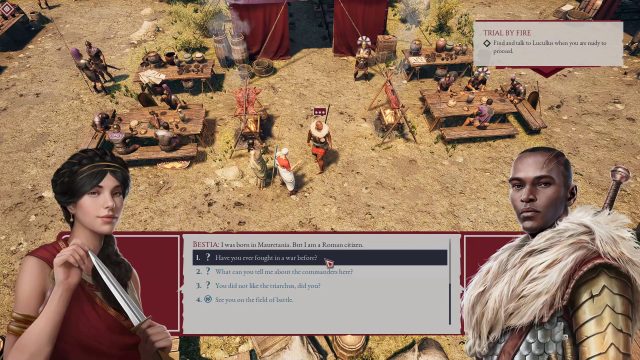Expeditions: Rome Review Impressions – An Enthralling Experience of Ancient Rome. In this Expeditions: Rome Review Impressions – An Enthralling Experience of Ancient Rome, we’re going to take a deep dive into the upcoming tactical Turn-based RPG inspired by the events that happened in Ancient Rome. Expeditions: Rome features a lot of interesting mechanics such as the hex-based combat system and outpost management. But does the gameplay work well cohesively? Is the game worth getting into when it releases on January 20, 2022? We’ll answer these questions and more!
Expeditions: Rome is developed by Logic Artists and published by THQ Nordic. The game will only be available on PC for Steam, GOG, and the Epic Game Store.
Expeditions: Rome Review Impressions – An Enthralling Experience of Ancient Rome
- Genre: Tactical Turn-based RPG
- Developed by: Logic Artists
- Published by: THQ Nordic
- Release date: January 20th, 2022
- Platforms: PC via Steam (Code Provided by Logic Artists)
- Price at the time of review: 44.99 USD
Expeditions: Rome Review Impressions – Story and Setting
Expeditions: Rome takes place during the ascent of Julius Caesar as one of the most powerful rulers in Ancient Rome. Political unrest remains to be common, which resulted in your father being suspiciously murdered. In a bid to save you, your mother decided to smuggle you out of Rome to join the ranks of the military. You’re aided by several trustworthy companions like Syneros to provide counsel and Caeso, who’s a highly devoted soldier.

As a young Legatus with barely any experience, your goal is to ultimately conquer Asia Minor, North Africa, and Gaul. But you first have to form alliances, strengthen your strategies in combat, and harness your ability to manage and lead your legion. Depending on the decisions you make, you’ll be viewed differently by the ones closest to you as well as those who doubt your potential. Do you have what it takes to gain the trust of your peers? Can you survive the scrutiny of nonbelievers and the Romans themselves? Will you rule as a tyrant or as a benevolent dictator?
Expeditions: Rome has multiple story beats that’ll constantly keep you invested in your character and companions. This is due to how impactful your choices are, which can drastically shift the outcome of a narrative.
During character creation, you’ll have to choose from 3 available perks or command specializations. These are Ethos where you technically rule with an iron fist and impose your authority; Logos where you convince people by utilizing your logic and reasoning skills; and Pathos where you emotionally win them over through manipulation.

Not everyone will agree with you and this is evident based on the personality you cultivate as a result. Nevertheless, every decision makes you feel like a legitimate commander of the Legio Victrix. For instance, in one quest, you’re made to choose between setting off bombs by the dock or stealthily eliminating sleepy soldiers to gain an advantage so you won’t have to fight as many enemies when the actual encounter starts. You can of course consider what your companions have to say but the final decision will still be yours, which is very interesting.
What’s more is that these choices allow you to form alliances, resulting in simpler conquests as they aid you in battle, or make enemies by antagonizing them further. This is similar to the classic RPGs of yesteryear like Baldur’s Gate and Planescape Torment. And it’s also the reason why I enjoy exploring the overworld map more and going deeper into quests. You never know when you’ll come across stories that would make you question the repercussions of your decisions. As the leader, the fate of your entire legion rests on your shoulders. Will you sacrifice the lives of the few to save the lives of the many?

Expeditions: Rome Review Impressions – Gameplay and Combat
Classes and Skills
Expeditions: Rome features 4 classes with 3 subclasses and skills for each, specifically the following:
- Princeps – Front-liners in combat who don heavy armor and tower shields. They can be a Defender to boost their survivability, a Vanguard who charges into combat and utilizes the shield as their main weapon, and a Veteran who is able to knock down and weaken enemies.
- Veles – Agile soldiers who generate Focus to activate extra skills in combat. Their subclasses include the Assassin who excels in executing single-target attacks, the Duelist who is adept at navigating the battlefield with ease due to their evasive tactics, and the Brawler who takes advantage of unarmed damage to penetrate enemy formations.
- Sagittarius – The only ranged attacker in the game with the ability to deal decent damage from afar. They can become a Marksman to hinder the movement of opponents, a Hunter who balances the damage they inflict up close or from a distance, and a Sniper to target single enemies with great precision.
- Triarius – The support class that buffs allies while weakening enemy performance. Their subclasses include the Medic to heal the party, the Flagbearer who uses crowd control to bolster the morale of their colleagues and to debilitate targets, and the Destroyer who shreds enemy armor with highly damaging blows.

What’s amazing about these subclasses is you’re not restricted to choosing just one skill tree. For instance, if you become a Princep, you can continue investing points into skills from the Defender, Vanguard, and Veteran Skill Lines should you see fit. As such, you can definitely mix and match skills to create multiple builds. However, it’s worth noting that as you invest more points into these the more you complete quests, you won’t be able to respec them so you need to be careful in investing wisely.

Skills aren’t only class-based since your characters can acquire more from the weapons they wield due to their weapon-swapping ability. For example, you can activate the Fire Arrow Weapon Skill to deal fire damage using your bow or to use Slash with your sword if you’re beside a target. But you don’t need to equip two weapons for all classes, most especially with the Triarius, because they need both hands to stabilize an affected ally and to restore their HP.
Combat and Difficulty
Expeditions: Rome’s combat mechanics are similar to that of Disciples: Liberation in terms of preparation and the actual encounter. To start off, you have to optimally position yourself and your allies on a hex-based layout. But unlike Disciples, this initial phase doesn’t have much of a bearing since the positioning area is relatively smaller. So there’s little choice you can make here that would give you a distinct advantage at the beginning.

In terms of tactical turn-based combat, the characters under your command have 1 Action Point each and a number of Movement Points based on their class. By default, the Sagittarius has the ability to move farther because of how nimble they are compared to the Princeps who are weighed down due to their heavy armor. This is where the turn-based nature of the game comes in full force. For every turn, you’re able to choose the characters in any order you wish as long as you consume all of their AP and movement like in Disciples: Liberation.
To make matters more interesting, killing specific enemy types such as Untrained Enemies and Gymnites rewards you with 1 additional AP during that same turn. But the catch is you can no longer reuse the previous skill you activated. If you’ve run out of valuable skills to use, which is pretty common in the early game, you can spend it to move farther on the battlefield instead.

Overall, combat feels very fluid and natural given how well-integrated the mechanics are. It’s also incredibly nuanced due to the number of options that are available to put yourself at an advantage. In classic D&D 5E fashion, you gain extra accuracy if you shoot arrows from higher ground. You can even trigger Attacks of Opportunity by moving beside enemy archers. This allows you to automatically attack them when they try to create distance between the two of you.
Additionally, you have to make use of tactical items, which include pilums or throwable items to deal shield damage, torches, and bandages. These are essentially your bonus actions during your turn so you can utilize them without spending any AP. There’s also the cover system to effectively block incoming attacks so be sure to hide before your turn ends to force enemies to use most of their movement and AP.

Every aspect of combat is necessary. Just like your choices in conversations, the ones you make in combat can send your army to their downfall. This is what makes encounters even more exciting given the high stakes involved. For instance, not bringing enough bandages to help out a bleeding ally can lead to injuries, which will eventually kill them if they don’t receive immediate treatment.
If you wish to challenge yourself further, you can increase the difficulty to Hard or Insane and simply enable the Combat Death option. Here, any of your allies, including your most trusted companions, can permanently die if they bleed out on the battlefield. There’s also an Iron Man Mode, which limits your saves to a single autosave, thereby forcing you to live with the most horrible decisions you’ve ever made.

Legion Skirmishes
Expeditions: Rome doesn’t only have turn-based combat, it also features legion skirmishes, which are mini conquests to further expand your army and reach. In this mode, you initially recruit Centurions who serve as commanders to lead the skirmishes themselves while you decide the strategies they should enact. Each phase consists of a selection of stratagems.

For instance, there’s Weak Centre that leaves your central formation vulnerable for enemies to funnel into. Your army will then ambush them from the sides to prevent them from escaping anywhere else. As a result, your opponents’ defenses fall but their aggression increases.

Compared to the game’s turn-based combat, however, these skirmishes aren’t as enticing as expected. More often than not, as long as your legion is nearly double the size of the enemy’s, your chances of victory are high by default. As such, there’s really not much strategy involved. The different classes of your Centurions don’t matter either since you won’t witness the action up close.

Instead, you see odd-looking square, diamond, and circular shapes fighting against each other, which feels like the mode has been rushed for the sake of completion. Thankfully, you have the Proceed and Auto-Resolve buttons at the lower right-hand corner of the screen to expedite these encounters.
Exploration and Outpost Management
Exploration takes you outside of your camp or outpost to a different interface or worldmap altogether. This map is only accessible when you’re traveling in the outside world. I would’ve wished that there’s a smaller version of this per district like in Kalloni so you can see where the structures are placed rather than relying on a compass, if you want to say, visit the Market.

Exploring outside of the outpost lets you examine your surroundings to check for ambushes, resources, and cities to conquer. The drawback to doing this extensively, however, is you become susceptible to running out of rations and water. This may result in hungry and exhausted Praetorians inciting a mutiny within their ranks.
As the Roman Legatus of Legio Victrix, you have the responsibility of upgrading your outpost. To do this, you need to assign soldiers to fulfill certain assignments. These take time and are therefore completed after several days. For instance, you can leave one of your Companions like Bestia Tabat in the Barracks to train recruits. Furthermore, you can gain access and upgrade structures, which require worldmap resources such as Farms, Lumber Mills, and Iron Mines by sending legionaries to do so.
You’re able to unlock the Armoury to craft equipment, the Workshop to increase the number of stratagems to choose from, and the Speculator Tent to replenish tactical items. You can even customize the colors and emblem of your legion.

Both the exploration and outpost management systems are engaging enough. Not only do they push you to progress in the story as you meet more characters and acquire resources, but they also improve your performance in combat. Specifically, the outpost upgrade feature makes you feel like the next powerful commander after Caesar since there are resources and citizens to manage.
Expeditions: Rome Review Impressions – Audio, Visual and Design
When it comes to Expeditions: Rome’s audio, you can expect to hear satisfactory soundtracks and sound effects. They both do a great job of eliciting the atmosphere of combat filled with bloodshed because of how loud and upbeat the rhythms are. What’s more is the music is also varied, making every encounter feel different from the one that came before. Meanwhile, the sound effects are equally enthralling as you hear the distinctive weapon clinks of a sword versus an arrow as they come into contact with armor.

Expeditions: Rome’s visuals are gorgeous because of its realistic-looking landscapes, which pop out even more due to the effective use of lighting and shadows. Regardless of whether you’re exploring out in the open or you’re traveling in cities, you’ll notice how vibrant and fantastic the textures and structures are, which adequately mimic Ancient Rome at its finest.

I do, however, wish for UI improvements in terms of the legion skirmishes’ design that isn’t as realistic and immersive as the rest of the world. This could be improved by using detailed soldier figures rather than shapes with different icons moving about in the field. But I imagine this will take more time to implement.
From a technical standpoint, the only minor issue I encountered was some framedrops here and there, but other than this, there were absolutely no bugs in the version that I played.
Expeditions: Rome Review Impressions – Replayability and Pricepoint
A single playthrough of Expeditions: Rome can take up to 65 hours to complete due to the companions you recruit, the major conquests you’ll engage in, and the legion and outpost you’ll manage. This doesn’t even take into account the number of times you can replay the game to try out other outcomes based on different choices as well as the skills you’ll be investing in next.

Expeditions: Rome is priced at USD 44.99, which is a decent pricepoint given the numerous hours you’ll spend playing the game. It also doesn’t feature any microtransactions so your progress is purely based on merit and time alone.
Expeditions: Rome Review Impressions – Final Thoughts
Expeditions: Rome provides you with an unforgettable experience of what it’s like to command an army in Ancient Rome. From the amount of intrigue that you have to quell to prevent uprising, to the outpost you have to manage to improve the morale of your soldiers, Logic Artists has successfully created a game worthy of being purchased on the first day of its release.

As a turn-based and strategy management RPG rolled into one, Expeditions: Rome encourages you to become the most effective leader there is. The learning curve isn’t harsh either, which makes it all the more enticing to play. But this doesn’t mean that you’re able to live with your choices without any consequences. I’ll certainly be checking out this game from time to time to see what the next updates and possible DLCs the developers will bring.
If you enjoyed this review be sure to check out Death’s Gambit Afterlife Review and Tales of Arise Review: A Beautiful Experience.
Summary: Expeditions: Rome is a fun and challenging RPG that requires closer attention. It brings back fond memories of the impactful choices made back in the days of classic RPGs like Baldur’s Gate and Planescape Torment. Moreover, the developers have made turn-based combat cohesively nuanced and challenging at the same time. With over 65 hours of content, Expeditions: Rome is worth getting into.
Story & Setting (9)
Gameplay (8.5)
Audio, Visual & Design (8)
Replayability (8)
Pricepoint (7)
























































